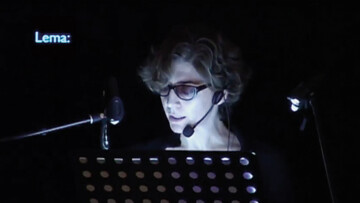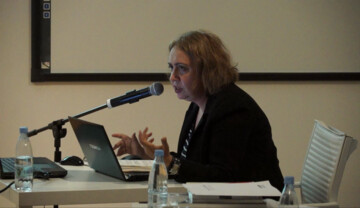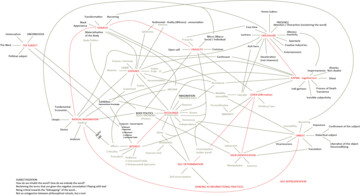Famously, the notion of “unrest” (Unruhe) is at the core of the Hegelian definition of the subject. Hegel refers here to Aristotle, for whom a subject is the one who moves by oneself (Hegel understands this as a work of self-reflection, dialectical negation, work of antagonisms), while subject’s counterpart, the object, is mainly characterised by its immobility. By reflexion of its own otherness and difference, the subject moves his way through time, while what the object does is occupy space. A subject does not exist outside the process of subjectivisation, of becoming.
The birth of the modern subject is often connected to its mobility, be it just flânerie or less leisurely displacement; self-reflection goes best while on a train or a plane, and even better when one finds oneself deracinated. In postmodern, neocapitalist, global society, better adapted subjects (like, let’s say, international curators, wandering theorists, or biennial artists) try to circulate as much as commodities, to demonstrate themselves rather than commodities, to become commodities, describing their mode de vie as constant self-design and themselves as readymades (as Boris Groys does). Talking readymades in changing circumstances – this is basically the description of both artists and artworks today. The artist (or curator, or theorist) is constantly moving around the globe to perform, basically, oneself in new contexts. Artworks have already been circulating like this for a century, but what is new today is the performative turn inside object-hood: the art object is in unrest as well, it is unstable, it is often a cluster of different site-specific versions of the same installation, video, or performance. From here, I can imagine going in two directions, which I outline here briefly.
Vector 1: Unrest of the object: performative turn and time-specific art
The dehumanisation of the subject goes hand in hand with the subjectivisation and humanisation of an artwork, a process that has been developing over the course of the 20th century. The → decolonisation of the subject-object → asymmetry and the shift towards more equality was part of the agenda of the historical avant-garde, especially Russian and Soviet, where abolishment of traditional painting (in its paradigmatic version, done by a male artist using a female model) was seen in the context of women’s liberation. Avant-garde’s “new objects” that define the range of forms of contemporary art today (installations, books, photomontages, even new types of painting) were to replace this old asymmetrical model of creation, as they were supposed to enjoy the status of friends and comrades to humans, or even of humans themselves.
One after-effect of this neo-human status is a different approach to the notion of quality, one that we profess today (without really reflecting on its novelty). De-commodified and subjectivised artworks reject the criterion of exchange value in favour of – not even use value – but “human value” that, ideally, would exclude any quantitative comparison.
Another consequence is the fact that the artwork is understood and shown in time rather than space. The “unrestful object” ceases to be identical to itself and is understood “in becoming”, as part of time-based practices (including performance), or even what I call → “time-specific exhibitions”. I recently produced one of these with Yuri Albert in Moscow, as his retrospective was constantly changing during the period it was open.
Vector 2: Immobilised subjects: fiction as subjectivisation
In this world of planetary mobility that is ours, what about immobilised subjects, excluded from the vortex of a global economy? I am talking here about the wretched of the earth and sky, those physically and economically challenged, but also those politically isolated and not even having access to the escape of immigration. Lots of attention is brought today to displacements, to legal as well as illegal migrants, to refugees, but to some extent these people are already privileged in comparison to those who have not found a way to leave the countries where they have neither → agency nor security. (For example, Not Even Refugees – the title of the new play by Keti Chukhrov that we just presented in Cologne, which she later changed to Not Even Dead – is about Russo-Georgian war of 1991.)

Keti Chukhrov, “Not Even Dead”, lecture performance, still from video documentation, 33' 39", a part of Reports to an Academy. A Non-academic Symposium, Performative or Otherwise, concept and presentation: Ekaterina Degot and David Riff, Kölnischer Kunstverein, 2014.
This immobilisation evokes, of course, the traumatic experience of isolation inside the communist block during Cold War – relative isolation in the case of Eastern European “people’s democracies”, total in the case of post-WWII, neo-modernist Soviet Union.
In this particular context of the post-war Soviet Union, at least, this isolated, confined, and nonglobal subject was raised in everyday educational practice, as well as conceptually constructed, as a radically global one, with an extremely → universalist approach to culture, where Marx, Shakespeare, Titian as well as Nasym Khikmet and Rabindranath Tagore, were considered the main intellectual landmarks of the Soviet subject (to a much bigger extent than local Russian culture). The Soviet Marxist philosopher Ewald Iljenkov, as well as other theorists, insisted that the true communist subject should build itself as a “holistic” one (vsestoronny – universalist, encompassing), i.e. as opposed to being “narrowly specialised”.
The desired width and amplitude of knowledge that encompassed world culture was to express the deconstruction of the capitalist division of → labour, as well as the democratic and internationalist aspiration for radical inclusion, and even aesthetic beauty, since the narrowly specialised was routinely described as “ugly one-sided”. However, since the real subject of this project, the Soviet individual, was strictly confined even in his or her own city let alone country, the experience of being “everywhere” and knowing “everything” had to be lived only vicariously, with an acute consciousness of one’s own political and geographical disability.
The enormously vast horizon of knowledge of contradictory cultures combined with this confinement represented the unrest of an immobilised subject. That subject invested him/herself in imagining oneself elsewhere and someone else, in the culture of → translation, fiction, imposture, irony and cynicism – all these words could be substituted for unrest as the title of this fragment, as instruments for the construction of → the subject in opposition to the hegemonic institutional narrative. As Brecht once said through the words of one of his characters, “the best school of dialectics is → emigration. The most acute dialecticians are refugees”. But Hegelian unrest and subjectivisation can also reside in the dis-mobility of inner emigration and not-even-asylum-seeking. (It goes without saying that the drastic and grim historical surprise of Russian aggression and civil war in Ukraine, as well as the abrupt change in the situation in Russia itself, represents the background of these brief reflections).




